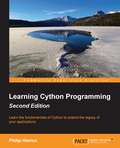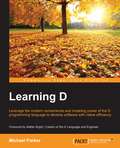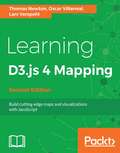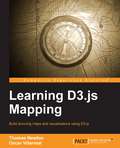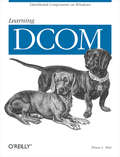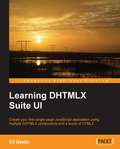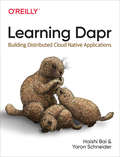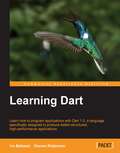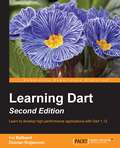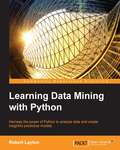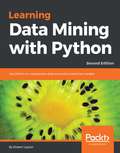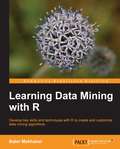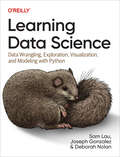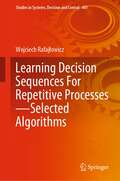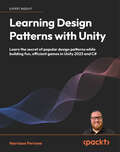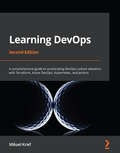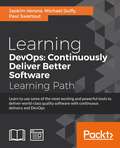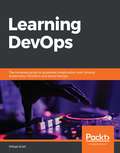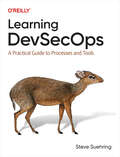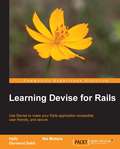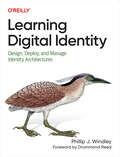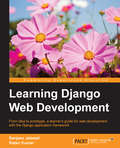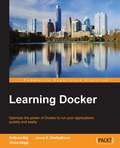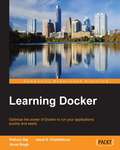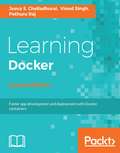- Table View
- List View
Learning Cython Programming - Second Edition
by Philip HerronLearn the fundamentals of Cython to extend the legacy of your applications About This Book * Learn how to extend C applications with pure Python code * Get more from Python - you'll not only learn Cython, you'll also unlock a greater understanding of how to harness Python * Packed with tips and tricks that make Cython look easy, dive into this accessible programming guide and find out what happens when you bring C and Python together! Who This Book Is For This book is for developers who are familiar with the basics of C and Python programming and wish to learn Cython programming to extend their applications. What You Will Learn * Reuse Python logging in C * Make an IRC bot out of your C application * Extend an application so you have a web server for rest calls * Practice Cython against your C++ code * Discover tricks to work with Python ConfigParser in C * Create Python bindings for native libraries * Find out about threading and concurrency related to GIL * Expand Terminal Multiplexer Tmux with Cython In Detail Cython is a hybrid programming language used to write C extensions for Python language. Combining the practicality of Python and speed and ease of the C language it's an exciting language worth learning if you want to build fast applications with ease. This new edition of Learning Cython Programming shows you how to get started, taking you through the fundamentals so you can begin to experience its unique powers. You'll find out how to get set up, before exploring the relationship between Python and Cython. You'll also look at debugging Cython, before moving on to C++ constructs, Caveat on C++ usage, Python threading and GIL in Cython. Finally, you'll learn object initialization and compile time, and gain a deeper insight into Python 3, which will help you not only become a confident Cython developer, but a much more fluent Python developer too. Style and approach This practical and a fast-paced guide gives you all the information you need to start programming using Cython.
Learning D
by Mike ParkerThis book is intended for those with some background in a C-family language who want to learn how to apply their knowledge and experience to D. Perhaps you're a college student looking to use D for hobby projects, or a career programmer interested in expanding your skillset. This book will help you get up to speed with the language and avoid common pitfalls that arise when translating C-family experience to D.
Learning D3.js 4 Mapping - Second Edition
by Thomas Newton Oscar Villarreal Lars VerspohlCrisp and concise guide on building impressive maps as well as visualizations with D3 a JavaScript library About This Book • Dive into D3.js and apply its powerful data binding ability in order to create stunning visualizations • Learn the key concepts of SVG, JavaScript, CSS and the DOM to bring data and shapes to live in the browser • Solve common problems faced while building interactive maps • Acquire key web development skills from the creating your interactive to testing and finally publishing it. Who This Book Is For This book is for people with at least a basic knowledge of of web development (basic HTML/CSS/JavaScript). You don't need to have worked with D3.js before. What You Will Learn • Work with SVG geometric shapes • Learn to manage map data and plot it with D3.js • Add interactivity and points of interest to your maps • Compress and manipulate geoJSON files with the use of topoJSON • Learn how to write testable D3.js visualizations • Build a globe with D3.js and Canvas and add interactivity to it. • Create a hexbin map with D3.js In Detail D3.js is a visualization library used for the creation and control of dynamic and interactive graphical forms. It is a library used to manipulate HTML and SVG documents as well as the Canvas element based on data. Using D3.js, developers can create interactive maps for the web, that look and feel beautiful. This book will show you how build and design maps with D3.js and gives you great insight into projections, colors, and the most appropriate types of map. The book begins by helping you set up all the tools necessary to build visualizations and maps. Then it covers obtaining geographic data, modifying it to your specific needs, visualizing it with augmented data using D3.js. It will further show you how to draw and map with the Canvas API and how to publish your visualization. By the end of this book, you'll be creating maps like the election maps and the kind of infographics you'll find on sites like the New York Times. Style and approach This step by step guide with pragmatic examples will help you create maps and amazing visualizations.
Learning D3.js Mapping
by Thomas Newton Oscar VillarrealIf you are interested in creating maps for the web GIS data, this book is for you. Familiarity with D3.js will be helpful but is not necessary.
Learning DCOM
by Thuan L. ThaiDCOM -- the Distributed Component Object Model -- is a recent upgrade of a time-honored and well-tested technology promoted by Microsoft for distributed object programming. Now that components are playing a larger and larger part in Windows 98, Windows NT 4.0, and Windows 2000, every Windows programmer will want to understand the technology. DCOM competes with CORBA as a rich and robust method for creating expandable and flexible components, allowing you to plug in new parts conveniently and upgrade without the need for code changes to every program that uses your component.This book introduces C++ programmers to DCOM and gives them the basic tools they need to write secure, maintainable programs. While using Visual C++ development tools and wizards where appropriate, the author never leaves the results up to magic. The C++ code used to create distributed components and the communications exchanged between systems and objects are described at a level where the reader understands their significance and can use the insights for such tasks as debugging and improving performance.The first few chapters explain both the remote procedure calls that underlie DCOM's communication and the way DCOM uses C++ classes. Readers become firmly grounded in the relation between components, classes, and objects, the ways objects are created and destroyed, how clients find servers, and the basics of security and threading.After giving you a grounding in how DCOM works, this book introduces you to the Microsoft tools that make it all easy. By showing what really happens each time you choose a button in a wizard, Learning DCOM makes it possible for you to choose what you need.This book is for anyone who wants to understand DCOM. While thoroughly practical in its goals, it doesn't stint on the background you need to make your programs safe, efficient, and easy to maintain.Topics include:MIDL (Microsoft Interface Definition Language, the language for defining COM interfaces)COM error and exception handlingCustom, dispatch, and dual interfacesStandard and custom factoriesManagement of in-process versus out-of-process serversDistributed memory managementPragmatic explanation of the DCOM wire protocolStandard, custom, handler, and automation marshaling Multithreading and apartmentsSecurity at the system configuration and programming levelActive Template Library (ATL), ATL wizards -- and what they don't doWriting a component that can be invoked from Visual BasicTechniques for using distributed componentsCreating an ActiveX control and embedding it in a Web clientAuthentication and the use of Windows NT security featuresTechniques for merging marshaling codeConnection and distributed events managementAn introduction to COM+ features
Learning DHTMLX Suite UI
by Eli GeskeA fast-paced, example-based guide to learning DHTMLX."Learning DHTMLX Suite UI" is for web designers who have a basic knowledge of JavaScript and who are looking for powerful tools that will give them an extra edge in their own application development. This book is also useful for experienced developers who wish to get started with DHTMLX without going through the trouble of learning its quirks through trial and error. Readers are expected to have some knowledge of JavaScript, HTML, Document Object Model, and the ability to install a local web server.
Learning Dapr
by Haishi Bai Yaron SchneiderGet the authoritative guide to Dapr, the distributed application runtime that works with new and existing programming languages alike. Written by the model’s creators, this introduction shows you how Dapr not only unifies stateless, stateful, and actor programming models but also runs everywhere—in the cloud or on the edge.Authors Haishi Bai and Yaron Schneider with Microsoft’s Azure CTO team explain that, with Dapr, you don’t need to include any SDKs or libraries in your user code. Instead, you automatically get flexible binding, state management, the actor pattern, pub-sub, reliable messaging, and many more features. This book shows developers, architects, CIOs, students, and computing enthusiasts how to get started with Dapr.Learn the new programming model for cloud native applicationsWrite high-performance distributed applications without drilling into technical detailsUse Dapr with any language or framework to write microservices easilyLearn how Dapr provides consistency and portability through open APIs and extensible, community-driven componentsExplore how Dapr handles state, resource bindings, and pub-sub messaging to enable resilient event-driven architectures that scaleIntegrate cloud applications with various SaaS offerings, such as machine learning
Learning Dart
by Dzenan Ridjanovic Ivo Balbaert"Mastering Dart by Projects" is a step-by-step guide that aims to give you hands-on knowledge about programming in Dart using an example-based approach.If you want to become a web developer, or perhaps you already are a web developer but you want to add Dart to your tool belt, then this book is for you. This book assumes that you have at least some knowledge of HTML and how web applications work. Some previous programming experience, preferably in a modern language like C#, Java, Python, Ruby, or JavaScript, will also give you a head start. You can also work with Dart on your preferred platform, be it Linux, Mac OS X, or Windows.
Learning Dart - Second Edition
by Dzenan Ridjanovic Ivo BalbaertLearn to develop high performance applications with Dart 1.10 About This Book * Develop apps for the modern web using Dart and HTML5 * Clarify and shorten your Dart code using enums * Build a complex UI for business applications with Dart's Polymer framework, based on web components Who This Book Is For If you want to become a developer for the modern web, or wish to add Dart to your tool belt, then this book is for you. The book assumes you have basic HTML experience and know how web applications work. Some previous programming experience, preferably in a modern language like C#, Java, Python, Ruby or JavaScript, will give you a head start. You can work with Dart on your preferred platform, be it Linux, Mac OS X or Windows. What You Will Learn * Structure your code using functions, classes, generics, packages and libraries * Use the power of modern browsers to process and store data * Make games by drawing, and using audio and video in the browser * Develop an application with a model-driven and spiral-paced approach * Discover the Observatory tools for profiling memory and CPU usage of Dart programs * Store your app's data in MySQL and MongoDB through Dart * Build powerful HTML5 forms, validate and store data in local storage, and use web components to build your own user interface * Run your Dart server on an App Engine Managed VM In Detail Dart is an open source programming language for the web, developed at Google, with a steadily growing community. It is a single language for both client and server, appropriate for the full range of devices on the web - including phones, tablets, laptops, and servers. It encompasses the lessons of the last two decades of web programming. This book will give you a thorough overview of Dart, taking you through its ecosystem, syntax, and development principles. With this book, you will build web games using HTML5, audio, and video, and also dive into processing and displaying data in HTML5 forms with Dart. You will also learn how web components fit together with HTML5, and how to apply them in business web applications of the future. You will discover how to store data on the client, communicate data between client and server with JSON, and store JSON data with MongoDB and MySQL. Stop solving new challenges with the same old tools - let Dart show you a whole new way. Style and approach This book provides you a project-based approach, with everything you need to start or enhance your career in the future of web development with Dart. It follows the spiral approach: each project builds up in successive spirals, adding new features in each step.
Learning Data Mining with Python
by Robert Layton<P><P>Harness the power of Python to analyze data and create insightful predictive models <P><P>About This Book <P><P>Learn data mining in practical terms, using a wide variety of libraries and techniques <P><P>Learn how to find, manipulate, and analyze data using Python <P><P>Step-by-step instructions on creating real-world applications of data mining techniques <P><P>Who This Book Is For <P><P>If you are a programmer who wants to get started with data mining, then this book is for you. <P><P>What You Will Learn <P><P>Apply data mining concepts to real-world problems <P><P>Predict the outcome of sports matches based on past results <P><P>Determine the author of a document based on their writing style <P><P>Use APIs to download datasets from social media and other online services <P><P>Find and extract good features from difficult datasets <P><P>Create models that solve real-world problems <P><P>Design and develop data mining applications using a variety of datasets <P><P>Set up reproducible experiments and generate robust results <P><P>Recommend movies, online celebrities, and news articles based on personal preferences <P><P>Compute on big data, including real-time data from the Internet <P><P>In Detail <P><P>The next step in the information age is to gain insights from the deluge of data coming our way. Data mining provides a way of finding this insight, and Python is one of the most popular languages for data mining, providing both power and flexibility in analysis. <P><P>This book teaches you to design and develop data mining applications using a variety of datasets, starting with basic classification and affinity analysis. Next, we move on to more complex data types including text, images, and graphs. In every chapter, we create models that solve real-world problems. <P><P>There is a rich and varied set of libraries available in Python for data mining. This book covers a large number, including the IPython Notebook, pandas, scikit-learn and NLTK. <P><P>Each chapter of this book introduces you to new algorithms and techniques. By the end of the book, you will gain a large insight into using Python for data mining, with a good knowledge and understanding of the algorithms and implementations.
Learning Data Mining with Python - Second Edition
by Robert LaytonHarness the power of Python to develop data mining applications, analyze data, delve into machine learning, explore object detection using Deep Neural Networks, and create insightful predictive models. About This Book • Use a wide variety of Python libraries for practical data mining purposes. • Learn how to find, manipulate, analyze, and visualize data using Python. • Step-by-step instructions on data mining techniques with Python that have real-world applications. Who This Book Is For If you are a Python programmer who wants to get started with data mining, then this book is for you. If you are a data analyst who wants to leverage the power of Python to perform data mining efficiently, this book will also help you. No previous experience with data mining is expected. What You Will Learn • Apply data mining concepts to real-world problems • Predict the outcome of sports matches based on past results • Determine the author of a document based on their writing style • Use APIs to download datasets from social media and other online services • Find and extract good features from difficult datasets • Create models that solve real-world problems • Design and develop data mining applications using a variety of datasets • Perform object detection in images using Deep Neural Networks • Find meaningful insights from your data through intuitive visualizations • Compute on big data, including real-time data from the internet In Detail This book teaches you to design and develop data mining applications using a variety of datasets, starting with basic classification and affinity analysis. This book covers a large number of libraries available in Python, including the Jupyter Notebook, pandas, scikit-learn, and NLTK. You will gain hands on experience with complex data types including text, images, and graphs. You will also discover object detection using Deep Neural Networks, which is one of the big, difficult areas of machine learning right now. With restructured examples and code samples updated for the latest edition of Python, each chapter of this book introduces you to new algorithms and techniques. By the end of the book, you will have great insights into using Python for data mining and understanding of the algorithms as well as implementations. Style and approach This book will be your comprehensive guide to learning the various data mining techniques and implementing them in Python. A variety of real-world datasets is used to explain data mining techniques in a very crisp and easy to understand manner.
Learning Data Mining with R
by Bater MakhabelThis book is intended for the budding data scientist or quantitative analyst with only a basic exposure to R and statistics. This book assumes familiarity with only the very basics of R, such as the main data types, simple functions, and how to move data around. No prior experience with data mining packages is necessary; however, you should have a basic understanding of data mining concepts and processes.
Learning Data Science: Data Wrangling, Exploration, Visualization, and Modeling with Python
by Deborah Nolan Sam Lau Joseph GonzalezAs an aspiring data scientist, you appreciate why organizations rely on data for important decisions--whether it's for companies designing websites, cities deciding how to improve services, or scientists discovering how to stop the spread of disease. And you want the skills required to distill a messy pile of data into actionable insights. We call this the data science lifecycle: the process of collecting, wrangling, analyzing, and drawing conclusions from data.Learning Data Science is the first book to cover foundational skills in both programming and statistics that encompass this entire lifecycle. It's aimed at those who wish to become data scientists or who already work with data scientists, and at data analysts who wish to cross the "technical/nontechnical" divide. If you have a basic knowledge of Python programming, you'll learn how to work with data using industry-standard tools like pandas.Refine a question of interest to one that can be studied with dataPursue data collection that may involve text processing, web scraping, etc.Glean valuable insights about data through data cleaning, exploration, and visualizationLearn how to use modeling to describe the dataGeneralize findings beyond the data
Learning Decision Sequences For Repetitive Processes—Selected Algorithms (Studies in Systems, Decision and Control #401)
by Wojciech RafajłowiczThis book provides tools and algorithms for solving a wide class of optimization tasks by learning from their repetitions. A unified framework is provided for learning algorithms that are based on the stochastic gradient (a golden standard in learning), including random simultaneous perturbations and the response surface the methodology. Original algorithms include model-free learning of short decision sequences as well as long sequences—relying on model-supported gradient estimation. Learning is based on whole sequences of a process observation that are either vectors or images. This methodology is applicable to repetitive processes, covering a wide range from (additive) manufacturing to decision making for COVID-19 waves mitigation. A distinctive feature of the algorithms is learning between repetitions—this idea extends the paradigms of iterative learning and run-to-run control. The main ideas can be extended to other decision learning tasks, not included in this book. The text is written in a comprehensible way with the emphasis on a user-friendly presentation of the algorithms, their explanations, and recommendations on how to select them. The book is expected to be of interest to researchers, Ph.D., and graduate students in computer science and engineering, operations research, decision making, and those working on the iterative learning control.
Learning Design Patterns with Unity: Learn the secret of popular design patterns while building fun, efficient games in Unity 2023 and C#
by Harrison FerroneBuild optimized games & elevate your skills with popular software design patterns in Unity 2023 and C#! Purchase of the print or Kindle book includes a free eBook in PDF formatKey FeaturesCraft engaging Unity 2023 games while mastering design patterns like Singleton, Object Pool, and more Write clean, reusable C# code using creational, behavioral, and structural patterns, tailored for the game development environment Go beyond basic design pattern usage and learn to customize and extend them for your unique game design needsBook DescriptionStruggling to write maintainable and clean code for your Unity games? Look no further! Learning Design Patterns with Unity empowers you to harness the fullest potential of popular design patterns while building exciting Unity projects. Through hands-on game development, you'll master creational patterns like Prototype to efficiently spawn enemies and delve into behavioral patterns like Observer to create reactive game mechanics. As you progress, you'll also identify the negative impacts of bad architectural decisions and understand how to overcome them with simple but effective practices. By the end of this Unity 2023 book, the way you develop Unity games will change. You'll emerge not just as a more skilled Unity developer, but as a well-rounded software engineer equipped with industry-leading design patterns. What you will learnImplement a persistent game manager using the Singleton pattern Spawn projectiles efficiently with Object Pooling for optimized performance Build a flexible crafting system using the Factory Method pattern Design an undo/redo system for player movement with the Command pattern Implement a state machine to control a two-person battle system Modify existing character objects with special abilities using the Decorator pattern Who this book is forThis book is your perfect companion if you're a Unity game developer looking to level up your C# skills and embrace industry standards for building robust games. Knowledge of Unity and basic C# programming is recommended.
Learning DevOps: A comprehensive guide to accelerating DevOps culture adoption with Terraform, Azure DevOps, Kubernetes, and Jenkins, 2nd Edition
by Mikael KriefImplement modern DevOps techniques to increase business productivity, agility, reliability, security, and scalabilityKey FeaturesLearn how to use business resources effectively for improved productivity and collaborationUse infrastructure as code practices to build large-scale cloud infrastructureLeverage the ultimate open source DevOps tools to achieve continuous integration and continuous delivery (CI/CD)Book DescriptionIn the implementation of DevOps processes, the choice of tools is crucial to the sustainability of projects and collaboration between developers and ops. This book presents the different patterns and tools for provisioning and configuring an infrastructure in the cloud, covering mostly open source tools with a large community contribution, such as Terraform, Ansible, and Packer, which are assets for automation.This DevOps book will show you how to containerize your applications with Docker and Kubernetes and walk you through the construction of DevOps pipelines in Jenkins as well as Azure pipelines before covering the tools and importance of testing. You'll find a complete chapter on DevOps practices and tooling for open source projects before getting to grips with security integration in DevOps using Inspec, Hashicorp Vault, and Azure Secure DevOps kit. You'll also learn about the reduction of downtime with blue-green deployment and feature flags techniques before finally covering common DevOps best practices for all your projects.By the end of this book, you'll have built a solid foundation in DevOps and developed the skills necessary to enhance a traditional software delivery process using modern software delivery tools and techniques.What you will learnUnderstand the basics of infrastructure as code patterns and practicesGet an overview of Git command and Git flowInstall and write Packer, Terraform, and Ansible code for provisioning and configuring cloud infrastructure based on Azure examplesUse Vagrant to create a local development environmentContainerize applications with Docker and KubernetesApply DevSecOps for testing compliance and securing DevOps infrastructureBuild DevOps CI/CD pipelines with Jenkins, Azure Pipelines, and GitLab CIExplore blue-green deployment and DevOps practices for open sources projectsWho this book is forIf you are an application developer or a system administrator interested in understanding continuous integration, continuous delivery, and containerization with DevOps tools and techniques, this book is for you. Knowledge of DevOps fundamentals and Git principles is required.
Learning DevOps: Continuously Deliver Better Software
by Michael Duffy Paul Swartout Joakim VeronaLearn to use some of the most exciting and powerful tools to deliver world-class quality software with continuous delivery and DevOps About This Book * Get to know the background of DevOps so you understand the collaboration between different aspects of an IT organization and a software developer * Deploy top-quality software and ensure software maintenance and release management with this practical guide * This course covers some of the most exciting technology available to DevOps engineers, and demonstrates multiple techniques for using them * Real-world and realistic examples are provided to help you as you go about the implementation and adoption of continuous delivery and DevOps Who This Book Is For This course is for developers who want to understand how the infrastructure that builds today's enterprises works, and how to painlessly and regularly ship quality software. What You Will Learn * Set up and familiarize yourself with all the tools you need to be efficient with DevOps * Design an application that is suitable for continuous deployment systems with DevOps in mind * Test the code using automated regression testing with Jenkins Selenium * Managing the lifecycle of hosts, from creation to ongoing management using Puppet Razor * Find out how to manage, use, and work with Code in the Git version management system * See what traps, pitfalls, and hurdles to look out for as you implement continuous delivery and DevOps In Detail Harness the power of DevOps to boost your skill set and make your IT organization perform better. If you're keen to employ DevOps techniques to better your software development, this course contains all you need to overcome the day-to-day complications of managing complex infrastructures the DevOps way. Start with your first module - Practical DevOps - that encompasses the entire flow from code from testing to production. Get a solid ground-level knowledge of how to monitor code for any anomalies, perform code testing, and make sure the code is running smoothly through a series of real-world exercise, and develop practical skills by creating a sample enterprise Java application. In the second module, run through a series of tailored mini-tutorials designed to give you a complete understanding of every DevOps automation technique. Create real change in the way you deliver your projects by utilizing some of the most commendable software available today. Go from your first steps of managing code in Git to configuration management in Puppet, monitoring using Sensu, and more. In the final module, get to grips with the continuous delivery techniques that will help you reduce the time and effort that goes into the delivery and support of software. This Learning Path combines some of the best that Packt has to offer in one complete, curated package. It includes content from the following Packt products: * Practical DevOps by Joakim Verona * DevOps Automation Cookbook by Michael Duffy * Continuous Delivery and DevOps : A Quickstart Guide - Second Edition by Paul Swartout Style and approach This course is an easy to follow project based guide for all those with a keen interest in deploying world-class software using some of the most effective and remarkable technologies available.
Learning DevOps: The complete guide to accelerate collaboration with Jenkins, Kubernetes, Terraform and Azure DevOps
by Mikael KriefSimplify your DevOps roles with DevOps tools and techniques Key Features Learn to utilize business resources effectively to increase productivity and collaboration Leverage the ultimate open source DevOps tools to achieve continuous integration and continuous delivery (CI/CD) Ensure faster time-to-market by reducing overall lead time and deployment downtime Book Description The implementation of DevOps processes requires the efficient use of various tools, and the choice of these tools is crucial for the sustainability of projects and collaboration between development (Dev) and operations (Ops). This book presents the different patterns and tools that you can use to provision and configure an infrastructure in the cloud. You'll begin by understanding DevOps culture, the application of DevOps in cloud infrastructure, provisioning with Terraform, configuration with Ansible, and image building with Packer. You'll then be taken through source code versioning with Git and the construction of a DevOps CI/CD pipeline using Jenkins, GitLab CI, and Azure Pipelines. This DevOps handbook will also guide you in containerizing and deploying your applications with Docker and Kubernetes. You'll learn how to reduce deployment downtime with blue-green deployment and the feature flags technique, and study DevOps practices for open source projects. Finally, you'll grasp some best practices for reducing the overall application lead time to ensure faster time to market. By the end of this book, you'll have built a solid foundation in DevOps, and developed the skills necessary to enhance a traditional software delivery process using modern software delivery tools and techniques What you will learn Become well versed with DevOps culture and its practices Use Terraform and Packer for cloud infrastructure provisioning Implement Ansible for infrastructure configuration Use basic Git commands and understand the Git flow process Build a DevOps pipeline with Jenkins, Azure Pipelines, and GitLab CI Containerize your applications with Docker and Kubernetes Check application quality with SonarQube and Postman Protect DevOps processes and applications using DevSecOps tools Who this book is for If you are a developer or a system administrator interested in understanding continuous integration, continuous delivery, and containerization with DevOps tools and techniques, this book is for you.
Learning DevSecOps: A Practical Guide to Processes and Tools
by Steve SuehringHow do some organizations maintain 24-7 internet-scale operations? How can organizations integrate security while continuously deploying new features? How do organizations increase security within their DevOps processes?This practical guide helps you answer those questions and more. Author Steve Suehring provides unique content to help practitioners and leadership successfully implement DevOps and DevSecOps. Learning DevSecOps emphasizes prerequisites that lead to success through best practices and then takes you through some of the tools and software used by successful DevSecOps-enabled organizations.You'll learn how DevOps and DevSecOps can eliminate the walls that stand between development, operations, and security so that you can tackle the needs of other teams early in the development lifecycle.With this book, you will:Learn why DevSecOps is about culture and processes, with tools to support the processesUnderstand why DevSecOps practices are key elements to deploying software in a 24-7 environmentDeploy software using a DevSecOps toolchain and create scripts to assistIntegrate processes from other teams earlier in the software development lifecycleHelp team members learn the processes important for successful software development
Learning Devise for Rails
by Hafiz Giovanni Sakti Nia MutiaraA hands-on, step-by-step guide to using Devise for authentication in Rails.If you are a web developer who is getting started with Rails and you are looking for authentication solutions, then this is the book for you. If you are a current Rails developer who is looking to extend your authentication implementation with capabilities such as authorization and remote authentication, this book will also be great for you.
Learning Digital Identity: Design, Deploy, and Manage Identity Architectures
by Phillip J. WindleyWhy is it difficult for so many companies to get digital identity right? If you're still wrestling with even simple identity problems like modern website authentication, this practical book has the answers you need. Author Phil Windley provides conceptual frameworks to help you make sense of all the protocols, standards, and solutions available and includes suggestions for where and when you can apply them.By linking current social login solutions to emerging self-sovereign identity issues, this book explains how digital identity works and gives you a firm grasp on what's coming and how you can take advantage of it to solve your most pressing identity problems. VPs and directors will learn how to more effectively leverage identity across their businesses.This book helps you:Learn why functional online identity is still a difficult problem for most companiesUnderstand the purpose of digital identity and why it's fundamental to your business strategyLearn why "rolling your own" digital identity infrastructure is a bad ideaDifferentiate between core ideas such as authentication and authorizationExplore the properties of centralized, federated, and decentralized identity systemsDetermine the right authorization methods for your specific applicationUnderstand core concepts such as trust, risk, security, and privacyLearn how digital identity and self-sovereign identity can make a difference for you and your organization
Learning Django Web Development
by Sanjeev Jaiswal Ratan KumarThis book is for web developers who want to get started with Django for web development. Basic knowledge of Python programming is required but no knowledge of Django is expected.
Learning Docker
by Pethuru Raj Jeeva S. ChelladhuraiIf you are an application developer who wants to learn Docker in order to utilize its features for application deployment, then this book is for you. No prior knowledge of Docker is required.
Learning Docker
by Pethuru Raj Jeeva S. Chelladhurai Vinod Singh<P><P>Optimize the power of Docker to run your applications quickly and easily <P><P>About This Book <P><P>Learn to compose, use, and publish the Docker containers <P><P>Leverage the features of Docker to deploy your existing applications <P><P>Explore real world examples of securing and managing Docker containers <P><P>Who This Book Is For <P><P>If you are an application developer who wants to learn Docker in order to utilize its features for application deployment, then this book is for you. No prior knowledge of Docker is required. <P><P>What You Will Learn <P><P>Build a Docker image using Dockerfiles <P><P>Push and publish images on Docker Hub <P><P>Run your own private Docker Hub and upload images onto it <P><P>Create and run services inside a container to deploy your applications with ease <P><P>Share data between the Docker host and containers <P><P>Orchestrate multiple containers with Docker Compose <P><P>Test and debug applications inside a Docker container <P><P>Secure your Docker containers with SELinux <P><P>In Detail <P><P>Docker is a next-generation platform for simplifying application containerization life-cycle. Docker allows you to create a robust and resilient environment in which you can generate portable, composable, scalable, and stable application containers. <P><P>This book is a step-by-step guide that will walk you through the various features of Docker from Docker software installation to the impenetrable security of containers. The book starts off by elucidating the installation procedure for Docker and a few troubleshooting techniques. You will be introduced to the process of downloading Docker images and running them as containers. You'll learn how to run containers as a service (CaaS) and also discover how to share data among containers. Later on, you'll explore how to establish the link between containers and orchestrate containers using Docker Compose. You will also come across relevant details about application testing inside a container. You will discover how to debug a container using the docker exec command and the nsenter tool. Finally, you will learn how to secure your containers with SELinux and other proven methods.
Learning Docker - Second Edition
by Pethuru Raj Jeeva S. Chelladhurai Vinod SinghDocker lets you create, deploy, and manage your applications anywhere at anytime – flexibility is key so you can deploy stable, secure, and scalable app containers across a wide variety of platforms and delve into microservices architecture About This Book • This up-to-date edition shows how to leverage Docker's features to deploy your existing applications • Learn how to package your applications with Docker and build, ship, and scale your containers • Explore real-world examples of securing and managing Docker containers Who This Book Is For This book is ideal for developers, operations managers, and IT professionals who would like to learn about Docker and use it to build and deploy container-based apps. No prior knowledge of Docker is expected. What You Will Learn • Develop containerized applications using the Docker version 17.03 • Build Docker images from containers and launch them • Develop Docker images and containers leveraging Dockerfiles • Use Docker volumes to share data • Get to know how data is shared between containers • Understand Docker Jenkins integration • Gain the power of container orchestration • Familiarize yourself with the frequently used commands such as docker exec, docker ps, docker top, and docker stats In Detail Docker is an open source containerization engine that offers a simple and faster way for developing and running software. Docker containers wrap software in a complete filesystem that contains everything it needs to run, enabling any application to be run anywhere – this flexibily and portabily means that you can run apps in the cloud, on virtual machines, or on dedicated servers. This book will give you a tour of the new features of Docker and help you get started with Docker by building and deploying a simple application. It will walk you through the commands required to manage Docker images and containers. You'll be shown how to download new images, run containers, list the containers running on the Docker host, and kill them. You'll learn how to leverage Docker's volumes feature to share data between the Docker host and its containers – this data management feature is also useful for persistent data. This book also covers how to orchestrate containers using Docker compose, debug containers, and secure containers using the AppArmor and SELinux security modules. Style and approach This step-by-step guide will walk you through the features and use of Docker, from Docker software installation to the impenetrable security of containers.
